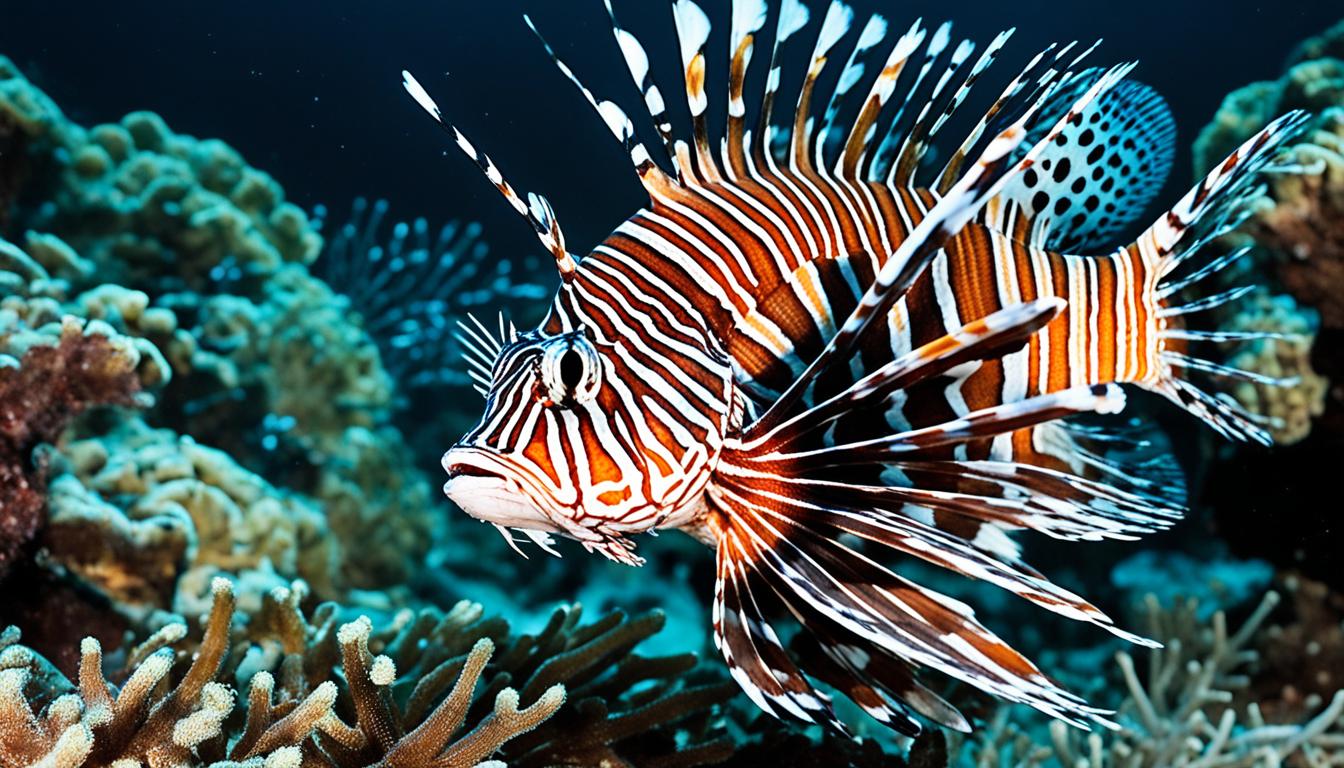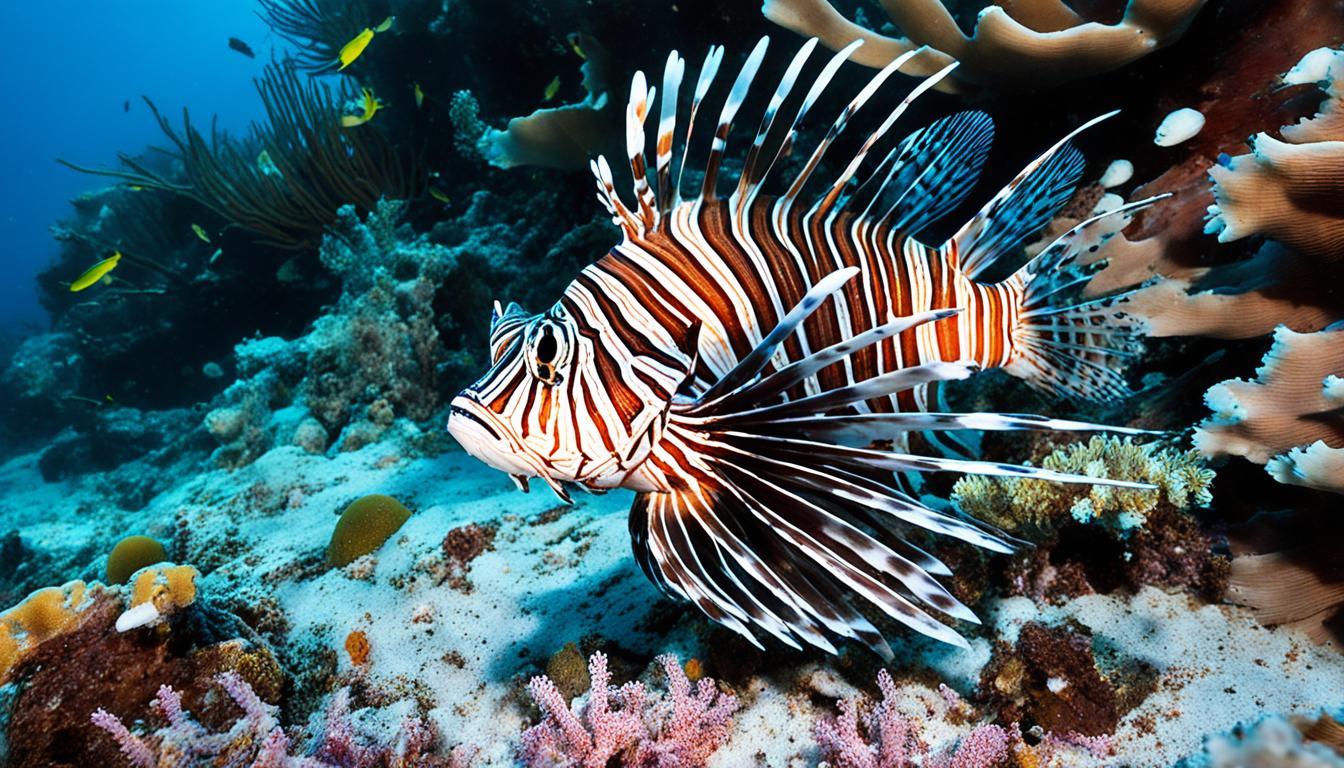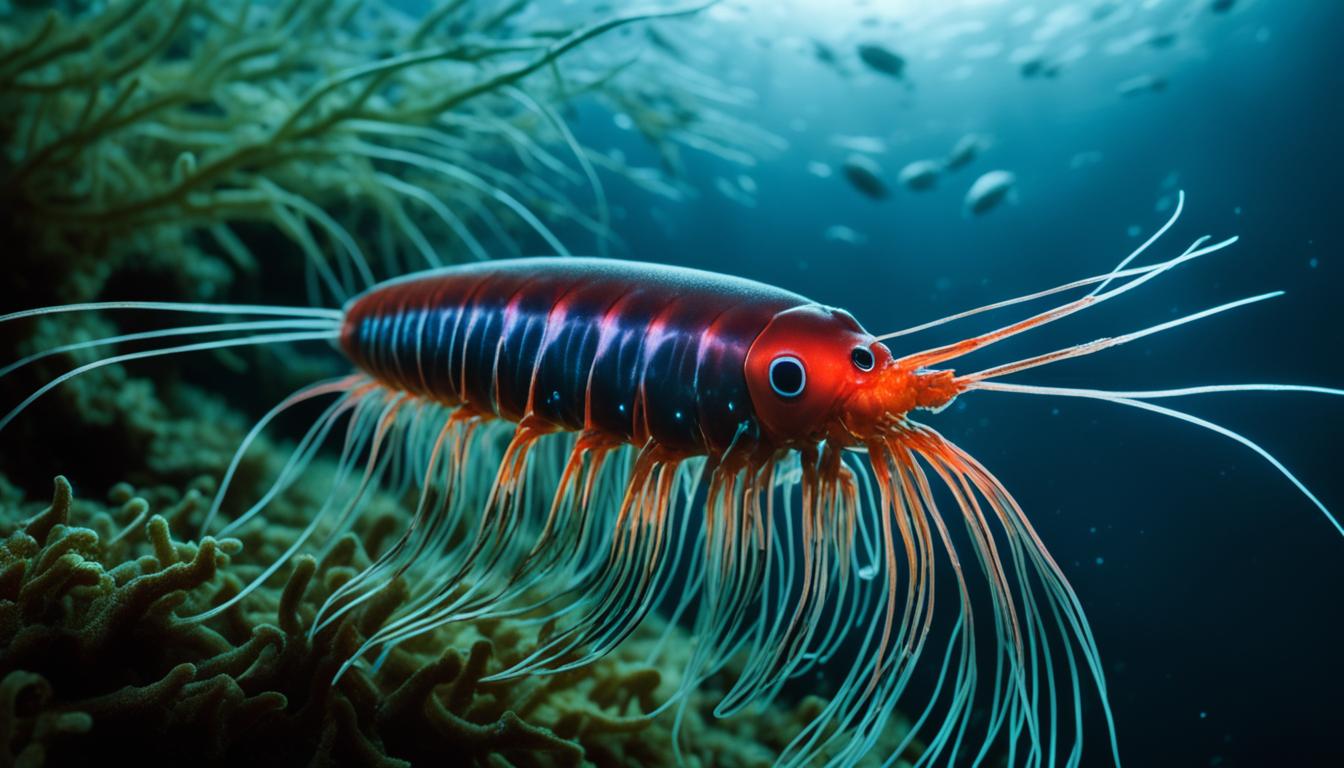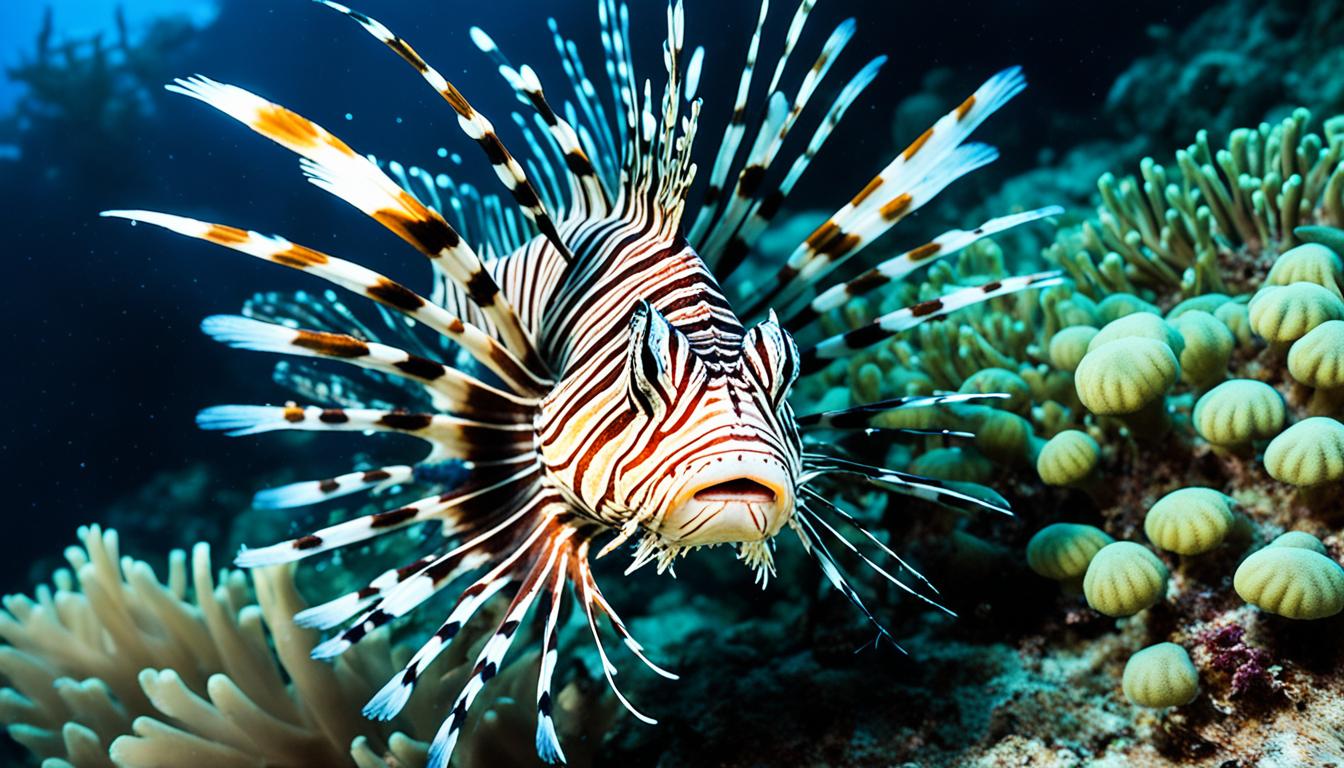The lionfish is known for its bright colors and detailed patterns. It has developed unique ways to protect itself in the wild. You might ask, how does the lionfish defend against predators in its environment? Its vibrant look is not just for beauty but also warns predators of its venomous spines.
These spines are key to the lionfish’s defense, not for catching food. They help the lionfish stay safe.
Lionfish live in the warm waters of the Indo-Pacific region. They have become invasive in places like the Caribbean and the southeastern U.S. Their defense strategies show how adaptable and resilient they are to environmental changes.
Lionfish Defense Mechanisms
Lionfish have many ways to stay safe in the ocean. Their main defense is their venomous spines. These spines are on their dorsal fins and keep away from threats. The bright colors of the lionfish also help protect them. These colors warn predators that the lionfish can be dangerous.
Lionfish also use smart behaviors to stay safe. They can change color to hide from predators. This helps them avoid being seen. With these tricks, lionfish can survive in a tough environment.
| Defense Mechanism | Description |
|---|---|
| Venomous Spines | Sharp spines that release venom to deter predators. |
| Distinctive Coloration | Bright patterns that signal toxicity and danger. |
| Camouflage | Blending into surrounding environments to avoid detection. |
| Behavioral Adaptations | Changing posture and movement to enhance evasion. |
Understanding Lionfish Venomous Spines
Lionfish have a special way to stay safe in the wild: their venomous spines. These spines keep predators away and show the characteristics of venomous spines important for defense.
Characteristics of the Venomous Spines
The lionfish has 18 sharp, venomous spines on its dorsal fins. These spines have venom glands inside. Unlike snakes, the lionfish’s spines don’t inject venom. Instead, they pierce the skin, letting venom in. This venom is full of proteins and neurotoxins, making it very painful for predators.
How Venom Works Against Predators
The lionfish’s venom makes it a strong defender. When a predator gets hurt by the spines, it feels a lot of pain and might even be unable to move. This stops bigger fish from going after the lionfish. The lionfish’s smart defense helps it stay safe in a world full of dangers.
How do lionfish defend themselves?
Lionfish have amazing ways to protect themselves from predators. They use visual warnings and camouflage to stay safe in the ocean. These strategies help them live in different marine places.
Visual Warnings Through Distinctive Appearance
Lionfish have bright colors that warn others of their venomous spines. These colors tell predators to stay away. This warning helps keep other fish from coming close.
By showing off their bright look, lionfish tell the world they are dangerous. This helps them survive in the ocean.
Camouflage Techniques in Natural Habitats
Lionfish also hide well using camouflage. They match the colors of coral reefs and rocky spots. This helps them catch prey and avoid big predators.
By being good at hiding, lionfish can be both hunters and the hunted. They stay ahead in their ocean world.
| Strategy | Description | Benefit |
|---|---|---|
| Visual Warnings | Bright stripes indicating venomous spines | Deters potential predators |
| Camouflage Techniques | Blending into coral and rocky backgrounds | Aids in ambushing prey and evading larger threats |
Lionfish Survival Tactics in the Wild
Lionfish are amazing predators with survival tactics that help them do well in different ocean areas. They use ambush feeding and smart ways to avoid dangers.
Role of Ambush Feeding Behavior
This fish has a sneaky way of hunting. They stay still during the day, hidden among coral or deep in the ocean. At night, they hunt by using their big pectoral fins to trap smaller fish. This makes them very good at catching prey.
Nautical Predator Evasion Strategies
Lionfish also know how to avoid predators. They move slowly and blend in with their surroundings. Their colors help them hide. This way, they can sneak up on prey without being seen. Their hunting and avoiding tactics work together to keep them safe.
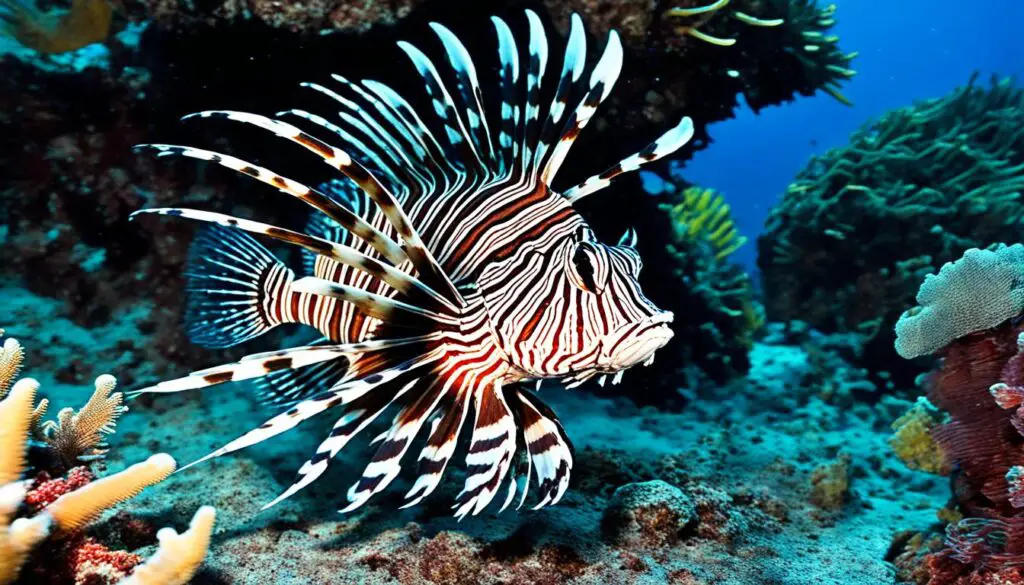
Lionfish Predators and Their Challenges
Lionfish are known for their strong defenses but face many challenges in their ecosystem. These challenges grow bigger because they are invasive in new homes. It’s important to understand how lionfish and their predators interact to see their effect on marine life.
Understanding the Ecosystem of Lionfish Predation
The lionfish’s ecosystem faces big challenges because not many animals can eat them. In places where they don’t belong, bigger fish do eat them. But, there aren’t enough predators to keep their numbers in check. This leads to more lionfish, which takes food away from native species.
This imbalance harms local ecosystems. We need to look into how unchecked lionfish growth affects these places.
Competitive Dynamics with Native Species
Lionfish fight hard with native species for food and space. This fight hurts the health of coral reefs. When lionfish move in, native species often decline.
It’s key to understand this competition to protect marine ecosystems. We need good management to keep these ecosystems healthy.
| Aspect | Lionfish | Native Species |
|---|---|---|
| Predation Pressure | Limited natural predators | Heavily predated by various marine animals |
| Competitive Behavior | Aggressive towards other species | More vulnerable under invasive conditions |
| Impact on Ecosystem | Overpopulation leads to imbalance | Declining numbers affect biodiversity |
The Impact of Lionfish Invasiveness
Lionfish have become a big problem in coral reef ecosystems. They harm native species by eating the small fish that are key to the reef’s health. This leads to a decline in these populations, affecting the food chain and marine life relationships.
Local fish populations find it hard to bounce back because lionfish keep eating them. This makes it tough for the reefs to stay healthy.
Native Species Threats in Coral Reefs
Lionfish live in many places and hurt the coral reefs by eating a lot. They can make native species populations drop, which are important for reef health. This is a big worry because it could destroy the balance of these ecosystems.
It’s crucial to watch and control lionfish numbers to protect the reefs.
Life Cycle and Spawning Frequency
Lionfish can lay millions of eggs each year, and they spawn often. This means their numbers can grow fast. Their breeding habits make it hard to manage their impact on marine life.
We need good conservation plans to deal with lionfish and protect coral reefs.

